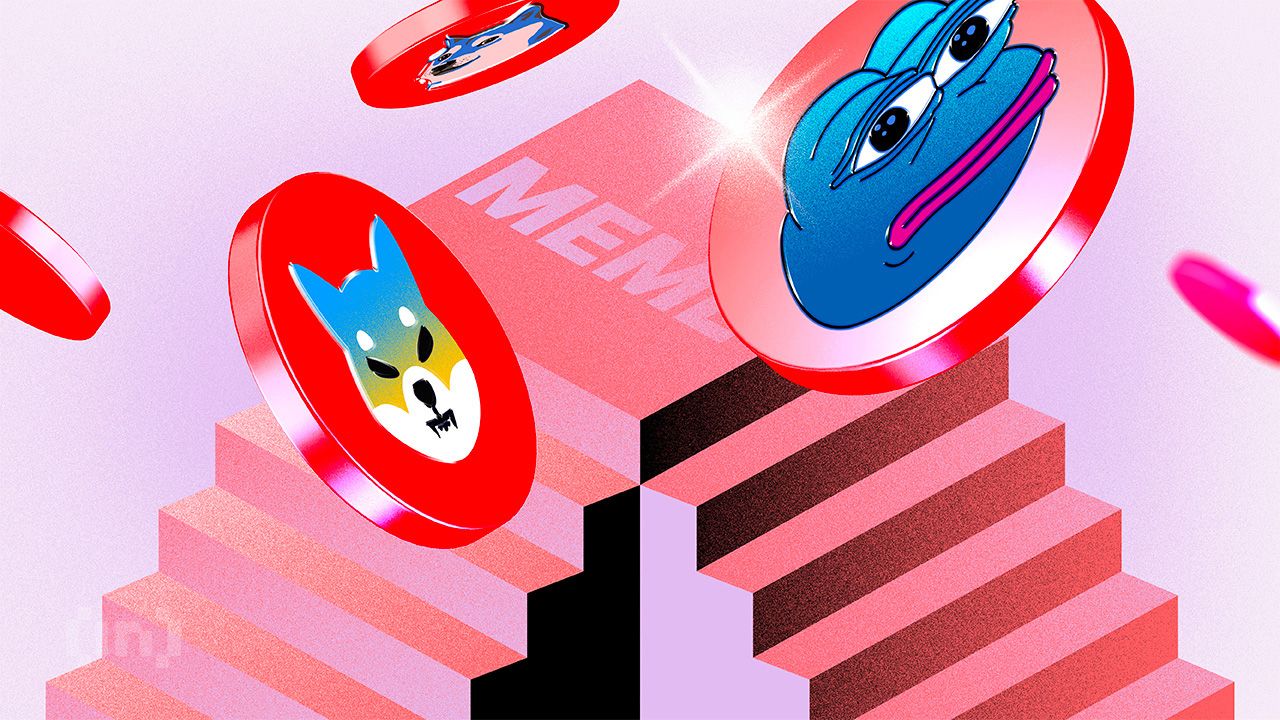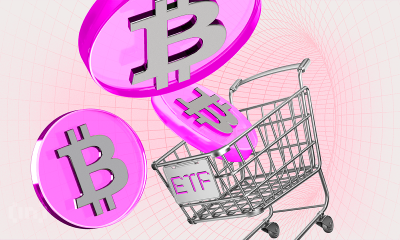Market
Market Making and Beyond: Insights from Vortex Co-Founder


Vortex, a prominent market maker, has become a reliable solution for projects facing growth and liquidity challenges. Founders often struggle with issues like stagnant token performance, weak chart metrics, and the risk of delisting from exchanges. Vortex addresses these problems with effective market-making algorithms, liquidity provision, and tailored advisory services that support project success.
In this interview, Vortex’s Co-Founder Gleb Gora discusses with BeInCrypto how the company’s’s strategic approach is driving sustainable growth for crypto projects in today’s competitive market
Can you share how Vortex started and how it evolved over time?
Vortex was first started as a vision of managing and growing wealth, providing an efficient trading infrastructure for professional and institutional traders in crypto. However, since 2021, we’ve seen a bigger opportunity in another niche, which was still pretty empty back then — market making. That’s when our vision consolidated into this journey and we’ve decided to fully move into the world of market making.
Vortex has adopted several unique market approaches, including various tech innovations and a broad range of strategic offerings for projects. However, what truly sets us apart is our client service. Over the years, we’ve refined our client communication to the highest level compared to our competitors. This focus on communication is a key metric where Vortex excels, contributing to our 93% client retention rate in 2023 and 85% year-to-date — outpacing the industry average by 25-30%.
Understanding your client needs is vital for any business, alongside efficient communication, which is absolutely crucial for profitable market making, especially when it comes to strategies based on project’s KPIs and unique needs. Alongside 24/7 support, that’s one of the key reasons why most of our clients make money while working with Vortex.
How does the world of market making look from the inside?
Since the beginning, we introduced Vortex’s proprietary trading software and dashboard, and we continuously improve them on a dynamic basis. Without spoiling all the juice, here are some of the key metrics and tools we rely on when managing markets.
- Order book integration from CEX with increased order history and added metrics which allow us to analyze the order book within seconds and make informed decisions based on that. Those metrics include order segregation, historical order book data, combined data across all exchanges and instant order execution based on that.
- Batch orders. A basic feature which allows you to instantly place multiple orders or execute them.
- Dynamic orders, a feature which allows to put efficient buy and sell walls.
- Advanced order execution, an automated tool which trades with the best bid and ask order to ensure dynamic trading environment.
- Proprietary trading algorithms designed for both T1 and T2 markets, tailored to meet the specific needs of each project. One of the most in-demand systems is our treasury-building algorithm.
- Additionally, we continuously refine a range of innovative tools, including metrics for stats, balance deltas, built-in PNL tracking, and more. We update and improve these features daily to ensure they deliver optimal market insights.
It’s very important to have a panel which meets all of the essential needs MMs face. An effective dashboard is a major part of success when it comes to executing most market making strategies, especially dynamic ones.
What are the main challenges market makers might face?
Market makers face various daily challenges, making it crucial to have dynamic tools for tracking accurate real-time data and automated algorithms that can trade without constant human intervention.
One of the most common issues is dealing with market takers who sell into the liquidity provided during volatile conditions. Market makers must offer liquidity 24/7, even in turbulent environments. During sell-offs or periods of high volatility, market takers can exploit this liquidity, leading to losses. While effective risk management and dynamic order strategies can mitigate this risk, it remains a key focus area for MMs.
In retainer-based market making, specific risks arise from inadequate client KPIs, especially in illiquid markets. A typical issue is excessive price support requested by projects without sufficient budgets or clear goals, leading to unnecessary spending. While not a direct risk, this challenge highlights the importance of projects listening to expert traders to avoid costly mistakes.
Does Vortex expand beyond market making?
Becoming a full-fledged token partner is one of the key visions behind creating Vortex. Apart from providing market making service, Vortex always goes beyond that and actively supports clients on:
Marketing. Vortex goes beyond standard market making by offering strategic marketing assistance. This includes introducing clients to top Key Opinion Leaders (KOLs) and leading marketing agencies. Vortex also offers guidance on developing and implementing marketing plans. This helps projects gain visibility and reach their target audience effectively.
Smart Contract Audits. Vortex ensures that projects are built on a secure foundation by offering comprehensive smart contract audits. These audits are conducted both in-house and through trusted partners, focusing on identifying potential vulnerabilities and ensuring the robustness of the contract’s code. This helps prevent security breaches and instills confidence in the project’s community and investors.
Strategic Web3 Advisory. Beyond market making, Vortex offers in-depth advisory services tailored to the unique challenges and opportunities within the Web3 space. This includes guiding clients through token launches, ecosystem development, and long-term strategic planning. The goal is to help projects achieve sustainable growth while navigating the rapidly evolving landscape of decentralized technologies.
Tokenomics Development and Audit. Vortex assists projects in designing and refining their tokenomics, ensuring that the economic model aligns with long-term project goals. This service includes auditing existing tokenomics structures to identify inefficiencies or areas for improvement. By offering data-driven insights, Vortex helps projects create token models that support liquidity, incentivize engagement, and foster ecosystem stability.
Providing all of the mentioned services proves highly valuable for many clients, as it ensures that market-making strategies align seamlessly with project plans and development timelines. This holistic approach enhances the effectiveness of market-making efforts by directly supporting the broader goals of each project.
Beyond these services, Vortex actively collaborates with over 20 launchpads and 15 venture capital firms, helping projects secure primary funding. We also plan to introduce our own launchpad by Q2 2025, further expanding the ecosystem.
What are the main trends driving the market right now, and where do you see things heading next?
Since I’ve started my journey in Web3, I’ve seen the space evolve so many times that it actually makes crypto completely different from what it was back in 2017. The NFT bags from 2021 are not going back to their ATH, most L0/1s turned out to be useless even as of today, rugs are more common than during the ICO boom and memes are now a major share of Web3.
I guess we can say that the space has evolved from building and innovating exciting tech to mostly pumping our own bags. We stopped caring about the fundamental part of most coins, predominantly focusing on hype, momentum and greed. Most innovative AI and blockchain projects are going down, while the Solana ecosystem grew. It’s obviously a temporary stage of the market, but it still sets us back from the initial vision behind Bitcoin in the first place.
I do believe that the next stage of crypto will be characterized as a stage of mass institutional adoption of crypto, which will completely evolve the space. DeFi and CeFi will most likely be even less interlinked than today, with DeFi slowly losing its market share over the years due to increased regulations from most nations.
The ETFs will be the key cash inflow to the market, influencing major altcoins and helping other similar projects grow as a whole asset class. Just like in every bull market before, most projects will lose a significant portion of their market cap, while others will capture their market share and many new solutions will appear, with a strong emphasis on RWA, AI and dApps.
What are the key factors that can make or break a project’s success?
Web3 is a very fascinating and somewhat complicated space with a unique blend of important traits a project has to have to become the next big thing. When it comes to success factors though, I would typically tend to divide short term success and long term vision as to different yet somewhat interconnected aspects.
Good momentum is achieved through a combination of effective community management, good brand that vibes with the overall space and/or strong support from respected industry experts. If those three are executed to a top-notch level, projects have enough momentum to generate sufficient buzz to shoot for the “next big thing” type of project. When it comes to long term success, we do have to account for more technical aspects — team execution, funding and economic model and, most importantly, the idea or vision itself.
Partnerships, backers and the overall vibe is crucial in helping the project get the initial traction — with enough experience, you can typically distinguish projects that have a shot from those that don’t in less than one minute just by checking those metrics.
Disclaimer
In compliance with the Trust Project guidelines, this guest expert article presents the author’s perspective and may not necessarily reflect the views of BeInCrypto. BeInCrypto remains committed to transparent reporting and upholding the highest standards of journalism. Readers are advised to verify information independently and consult with a professional before making decisions based on this content. Please note that our Terms and Conditions, Privacy Policy, and Disclaimers have been updated.
Market
Report Alleges Massive Meme Coin Sniping on Pump.fun

According to a new report from Pine Analytics, token deployers on Pump.fun systematically funded sniper wallets to buy their own meme coins. This impacted over 15,000 token launches on the platform.
These sniper wallets operated primarily during US trading hours, executing standardized, profitable strategies. Unrelated bot activity obscures their behavior, making it extremely difficult to isolate these wallets—and they can readily adapt to new countermeasures.
Snipers Roam Free on Pump.fun Meme Coins
Pump.fun has remained one of the most popular meme coin launchpads on Solana despite persistent controversies and other criticism.
However, Pine Analytics’ new report has uncovered a new controversy, discovering systematic market manipulation on the platform. These snipes include as much as 1.75% of all launch activity on Pump.fun.
“Our analysis reveals that this tactic is not rare or fringe — over the past month alone, more than 15,000 SOL in realized profit was extracted through this method, across 15,000+ launches involving 4,600+ sniper wallets and 10,400+ deployers. These wallets demonstrate unusually high success rates (87% of snipes were profitable), clean exits, and structured operational patterns,” it claimed.
Solana meme coin deployers on Pump.fun follow a consistent pattern. They fund one or more sniper wallets and grant them advance notice of upcoming token launches.
Those wallets purchase tokens in the very first block and then liquidate almost immediately—85% within five minutes and 90% in just one or two swap events.

Pump.fun meme coin developers exploit this tactic to create the appearance of immediate demand for their tokens. Retail investors, unaware of the prior sell‑off, often purchase these tokens after the snipe, giving developers an unfair advantage. This constitutes market manipulation and erodes trust in the platform.
Pine Analytics had to carefully calibrate its methods to identify genuine snipers. Apparently, 50% of meme coin launches on Pump.fun involve sniping, but most of this is probably bots using the “spray and pray” method.
However, by filtering out snipers with no direct links to developer wallets, the firm missed projects that covered their tracks through proxies and burners.
In other words, the meme coin community does not have adequate defenses against systematic abuse on Pump.fun. There are a few possible ways that the platform could flag repeat offenders and sketchy projects, but adaptive countermeasures could defeat them. This problem demands persistent and proactive action.
Unfortunately, it may be difficult to enact such policies. Meme coin sniping is so systematic that Pump.fun could only fight it with real commitment.
Analysts think that building an on-chain culture that rewards transparency over extraction is the best long-term solution. A shift like that would be truly seismic, and the meme coin sector might not survive it.
Disclaimer
In adherence to the Trust Project guidelines, BeInCrypto is committed to unbiased, transparent reporting. This news article aims to provide accurate, timely information. However, readers are advised to verify facts independently and consult with a professional before making any decisions based on this content. Please note that our Terms and Conditions, Privacy Policy, and Disclaimers have been updated.
Market
Solana Leads Blockchain Metrics as SOL Momentum Builds

Solana (SOL) continues to show strength across multiple fronts, maintaining a bullish structure on its Ichimoku Cloud chart while gaining momentum in key market metrics. The BBTrend indicator has turned higher again, signaling renewed buying pressure after a brief cooldown.
On-chain activity remains strong, with Solana leading all blockchains in DEX volume and dominating fee generation thanks to the explosive growth of meme coins and launchpad activity. With SOL now trading above a key resistance level, the path is open for further upside—though a loss of momentum could still trigger a retest of lower supports.
Solana Maintains Bullish Structure, but Momentum Faces Key Test
On Solana’s Ichimoku Cloud chart, the price is currently above the Kijun-sen (red base line) but has dipped below the Tenkan-sen (blue conversion line), signaling weakening short-term momentum.
The flattening Tenkan-sen and price behavior suggest possible consolidation or the early stages of a pullback. Still, with the price holding above the Kijun-sen, medium-term support remains intact.

The overall Ichimoku structure remains bullish, with a thick, rising cloud and leading span A well above span B—indicating strong underlying support.
If Solana finds support at the Kijun-sen and climbs back above the Tenkan-sen, the uptrend could regain strength; otherwise, a test of the cloud’s upper boundary may follow.

Meanwhile, Solana’s BBTrend is currently at 6, extending nearly ten days in positive territory after peaking at 17.5 on April 14. The recent increase from 4.26 to 6 suggests renewed bullish momentum following a brief cooldown.
BBTrend, or Bollinger Band Trend, tracks the strength of price movement based on Bollinger Band expansion.
Positive values like the current one point to an active uptrend, and if the BBTrend continues to rise, it could signal stronger momentum and potential for another upward move.
Solana Dominates DEX Volume and Fee Generation as Meme Coins Drive Ecosystem Growth
Solana has once again claimed the top spot among all chains in DEX volume, recording $15.15 billion over the past seven days. The combined total of Ethereum, BNB, Base, and Arbitrum reached $22.7 billion.

In the last 24 hours alone, Solana saw $1.67 billion in volume, largely fueled by its booming meme coin ecosystem and the ongoing launchpad battle between PumpFun and Raydium. Adding to this good momentum, Solana recently surpassed Ethereum in Staking Market Cap.

When it comes to application fees, Solana’s momentum is just as clear. Four of the top ten fee-generating apps over the past week—PumpFun, Jupiter, Jito, and Meteora—are Solana-focused.
Pump leads the pack with nearly $18 million in fees alone.
Solana Breaks Key Resistance as Uptrend Targets Higher Levels, but Risks Remain
Solana has finally broken above its key resistance at $136, flipping it into a new support level that was successfully tested just yesterday.
Its EMA lines remain aligned in a bullish setup, suggesting the uptrend is still intact.
If this momentum continues, SOL price could aim for the next resistance zones at $147 and $152—levels that, if breached, open the door to a potential move toward $179.

The current structure favors buyers, with higher lows and strong support reinforcing the trend.
However, if momentum fades, a retest of the $136 support is likely.
A breakdown below that level could shift sentiment, exposing Solana to deeper pullbacks toward $124 and even $112.
Disclaimer
In line with the Trust Project guidelines, this price analysis article is for informational purposes only and should not be considered financial or investment advice. BeInCrypto is committed to accurate, unbiased reporting, but market conditions are subject to change without notice. Always conduct your own research and consult with a professional before making any financial decisions. Please note that our Terms and Conditions, Privacy Policy, and Disclaimers have been updated.
Market
Crypto Firms Donated $85 million in Trump’s Inauguration

According to a new report, 15 firms and individuals from the crypto industry donated more than $100,000 to President Trump’s Inauguration, totaling over $85 million.
Almost all of these companies apparently received direct or indirect benefits from Trump’s administration. This includes dropped legal proceedings, lucrative business partnerships, participation in Trump’s Crypto Summit, and more.
Crypto Industry Went All-In on Trump’s Inauguration
Since promising to bring friendlier regulations on the campaign trail, Donald Trump attracted a reputation as the Crypto President.
Trump’s Inauguration festivities included a “Crypto Ball,” and several prominent firms made donations for these events. Today, a report has compiled all crypto-related contributions of over $100,000, revealing some interesting facts.

Since taking office, President Trump and his family have been allegedly involved in prominent crypto controversies, and these donations may be linked to several of them.
For example, eight of the donors, Coinbase, Crypto.com, Uniswap, Yuga Labs, Kraken, Ripple, Robinhood, and Consensys, had SEC investigations or lawsuits against them closed since Trump’s term began.
The commission might have dropped its probe against these companies anyway due to its changing stance on crypto enforcement. However, being in the President’s good books likely helped the process.
Further Alleged Benefits for Donors
In other words, nearly half the firms that made donations to Trump’s Inauguration have seen their legal problems cleared up quickly. This isn’t the only regulation-related benefit they allegedly received.
Circle, for example, recently made an IPO after openly stating that Trump’s Presidency made it possible. Galaxy Digital received SEC approval for a major reorganization, a key step for a NASDAQ listing.
Other donors, such as Crypto.com and ONDO, got more direct financial partnerships with businesses associated with the Trump family.
Previously, Ripple’s CEO, Brad Garlinghouse, anticipated a crypto bull market under Trump. Also, XRP, Solana, and Cardano were all unexpectedly included in the US Crypto Reserve announcement.
All three of these companies made major donations to Trump’s Inauguration.
It seems that most of the firms involved got at least some sort of noticeable benefit from these donations. Donors like Multicoin and Paradigm received invitations to Trump’s Crypto Summit, while much more prominent groups like the Ethereum Foundation got snubbed.
Meanwhile, various industry KOLs and community members have already alleged major corruption in Trump’s crypto connections.
While some allegations might lack substantial proof, the crypto space has changed dramatically under the new administration, for both good and bad.
Disclaimer
In adherence to the Trust Project guidelines, BeInCrypto is committed to unbiased, transparent reporting. This news article aims to provide accurate, timely information. However, readers are advised to verify facts independently and consult with a professional before making any decisions based on this content. Please note that our Terms and Conditions, Privacy Policy, and Disclaimers have been updated.
























